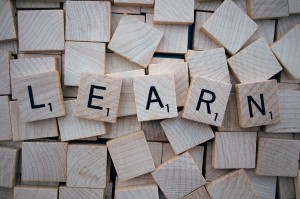
 Become a PowerPoint Guru by Dave Tracy
Become a PowerPoint Guru by Dave Tracy
Learn the methodologies, frameworks, and tricks used by Management Consultants to create executive presentations in the business world.

 Become a PowerPoint Guru by Dave Tracy
Become a PowerPoint Guru by Dave Tracy
 Organizational leadership can draw on 3 Strategic Thinking Games to master Business Strategy and apply in varied scenarios and organizational structures. The Strategic Thinking Games provide Decision Making models for senior executives to choose from and use as per the situation.
Organizational leadership can draw on 3 Strategic Thinking Games to master Business Strategy and apply in varied scenarios and organizational structures. The Strategic Thinking Games provide Decision Making models for senior executives to choose from and use as per the situation.
The Strategic Thinking Games are based on mathematics and statistics, particularly Probability Theory, and exhaustive research into the Business Strategy realm. Probability Theory is actually a branch of mathematics that deals with analysis of random phenomena. The basic element of Probability Theory is an experiment that can be at least hypothetically repeated under identical conditions, but may lead to different outcomes on different trials.
Each of the Strategic Thinking Games warrants employing a different mindset and decision-making approach to confront the challenges presented by a particular problem. Executives can apply these Strategic Thinking Models to control their future:
Let’s discuss these Strategic Thinking Models in detail.
The 1st Strategy game allows the players to make 40 blind draws from a pot holding 25 black and 75 red balls. It costs $10 per draw—which has to be paid beforehand—and it allows the players the opportunity to win $20 on drawing a red ball but naught on drawing a black ball. The game imitates a scenario where managers make informed bets about the future based on data and insights into the level of uncertainty encountered.
The Planning as Positioning Model enables the executives to learn about their industry and competition, gauge ambiguities and uncertainties, and select markets that have the potential to generate a positive Return on Investment (ROI).
A classic example of a company operating on the Planning & Positioning Model was the International Telephone and Telegraph Corporation (ITT). For 17 years, the company was led by Harold Geneen (from 1960 to 1977). Harold Geneen was unrestricted by any company mission. He expanded in multiple industries, acquired around 350 enterprises from varied industries, including auto parts, cosmetics, hospitality, insurance, and technology. As a formal accountant, Harold considered facts as indisputable, final, and a foundation for making strategic decisions. He would travel to far-flung regions to meet his business unit managers, who were free to make their own strategic decisions but were responsible for their unit’s performance and objectives’ achievement.
The 2nd Strategy game allows the players to blind draw from a pot containing an unknown mix of red and black balls. This time it costs $5 per draw. Players have to bet on either color before each draw. They can draw up to 50 times, or stop whenever they want, and win $20 if they draw the right ball. This game imitates a scenario for training managers to dynamically respond to upcoming events with unpredictable degree of uncertainty.
Through the pot filled with balls experiment, it was revealed that when people are given complicated choices, they behave in manners conflicting with their beliefs. In his famous Ellsberg Paradox, Ellsberg hypothesized that people make illogical preferences in order to avoid ambiguity. The Organizational Learning Model underlines that in a world full of uncertainties instead of spending too much time predicting the future, planning and positioning, organizations should devise and implement an evolving strategy, take one step at a time, search for viable patterns, and then adjust the course based on results.
An example of successful implementation of the 2nd Strategic Thinking Model is Corning Inc. that embraced Organizational Learning to develop a healthy product pipeline. The company developed Pyrex, TV tubes…..
Interested in learning more about the 3 Strategic Thinking Games? You can download an editable PowerPoint on Strategic Thinking Games here on the Flevy documents marketplace.
You can download in-depth presentations on this and hundreds of similar business frameworks from the FlevyPro Library. FlevyPro is trusted and utilized by 1000s of management consultants and corporate executives. Here’s what some have to say:
“My FlevyPro subscription provides me with the most popular frameworks and decks in demand in today’s market. They not only augment my existing consulting and coaching offerings and delivery, but also keep me abreast of the latest trends, inspire new products and service offerings for my practice, and educate me in a fraction of the time and money of other solutions. I strongly recommend FlevyPro to any consultant serious about success.”
– Bill Branson, Founder at Strategic Business Architects
“As a niche strategic consulting firm, Flevy and FlevyPro frameworks and documents are an on-going reference to help us structure our findings and recommendations to our clients as well as improve their clarity, strength, and visual power. For us, it is an invaluable resource to increase our impact and value.”
– David Coloma, Consulting Area Manager at Cynertia Consulting
“FlevyPro has been a brilliant resource for me, as an independent growth consultant, to access a vast knowledge bank of presentations to support my work with clients. In terms of RoI, the value I received from the very first presentation I downloaded paid for my subscription many times over! The quality of the decks available allows me to punch way above my weight – it’s like having the resources of a Big 4 consultancy at your fingertips at a microscopic fraction of the overhead.”
– Roderick Cameron, Founding Partner at SGFE Ltd
 Initiatives aimed at improving performance are often launched with great uproar, costing an organization significant investments. Such initiatives necessitate extensive changes in the Organizational Culture and the way the enterprise systems and processes function.
Initiatives aimed at improving performance are often launched with great uproar, costing an organization significant investments. Such initiatives necessitate extensive changes in the Organizational Culture and the way the enterprise systems and processes function.
However, most initiatives fall short of realizing success. Decades of scholarly research on Change Management reveals that the issues that contribute the most to the failure of strategic initiatives are:
Researchers have carried out scores of studies to isolate the drivers of lasting change. Research published in MIT SMR in 2005 discusses how leadership can design and execute Transformation initiatives that bring lasting changes in the organization. The study entailed in-depth analysis of the strategic Customer Service Enhancement (CSE) initiative undertaken by a large clothing retailer, having franchises in multiple geographic locations.
The researchers conducted 20 semi-structured interviews with leaders, in-store operations and support function managers. Detailed notes of the interviews were shared amongst the researchers alongside an exhaustive literature review. A case study of the initiative was prepared using independent research to have an unprejudiced viewpoint, free from any bias. Feedback from the organization’s management was gathered and incorporated throughout the study to seek clarifications or corrections. Data analysis was carried out employing a coding scheme developed using Atlas.ti tool. Comparative analysis was conducted and similarities and differences in conclusions were discussed.
The study brought to light 4 key processes necessary for change to stick in an organization. These key processes assist in laying the foundation for successful institutionalization of change initiatives by creating a company-wide culture that encourages enduring change:
Let’s delve deeper into the first 2 processes.
Chartering is a process through which an enterprise classifies the purpose, scope, and the way people interact with each other on a strategic initiative. Clear delineation of project boundaries, resources, responsibilities, and reporting lines are the elements integral for the success of a change initiative.
The Chartering process entails 2 critical components:
Boundary Setting involves the key steps a team takes for accurate definition of change initiative’s scope.
The project team should clearly outline the problem(s) that the project is, and isn’t, going to tackle. Ideally, while designing and executing a change initiative, the focus of the engagement should be on confronting the most crucial problem area. The leadership should ensure not to confuse the core team by eyeing too many priorities to deal with through the strategic initiative.
The Team Design element of Chartering involves ascertaining the roles, accountabilities, and guiding principles for team’s collaboration. Team design entails creating ground rules for team members to interact, devising mechanisms to manage conflicts. The leadership needs to not only maintain diversity of the project team’s expertise, but also ensure they complement each other, and inculcate a standardized approach to decision making in project teams. There needs to be fostered a culture of positive discourse and testing ideas amongst the team members. Incorporating these guidelines helps spark thinking, learning, and decision making.
Learning aids in anticipating and dealing with hurdles during implementation of Transformation initiatives. Learning enables the managers to improve the quality of the new processes. it is a process through which managers develop, test, and refine ideas before full-scale implementation. The process entails 2 critical components:
The discovery element involves gathering data to identify the objectives of the change initiative and outlining ways to achieve those objectives. Before rolling out a complete implementation of a change initiative, testing and refining the individual elements of the initiative immensely assists in the success of the initiative. Gathering adequate information relevant to the initiative, setting up baseline metrics to measure performance, and identifying issues hampering customer satisfactions are the key aspects of this phase. The team should learn from the failures of prior initiatives, introduce change in a systemic fashion rather than piecemeal, and encourage people to change rationally as well as emotionally.
Interested in learning more about the other processes critical for change to stick? You can download an editable PowerPoint on 4 Processes of Sustainable Change here on the Flevy documents marketplace.
You can download in-depth presentations on this and hundreds of similar business frameworks from the FlevyPro Library. FlevyPro is trusted and utilized by 1000s of management consultants and corporate executives. Here’s what some have to say:
“My FlevyPro subscription provides me with the most popular frameworks and decks in demand in today’s market. They not only augment my existing consulting and coaching offerings and delivery, but also keep me abreast of the latest trends, inspire new products and service offerings for my practice, and educate me in a fraction of the time and money of other solutions. I strongly recommend FlevyPro to any consultant serious about success.”
– Bill Branson, Founder at Strategic Business Architects
“As a niche strategic consulting firm, Flevy and FlevyPro frameworks and documents are an on-going reference to help us structure our findings and recommendations to our clients as well as improve their clarity, strength, and visual power. For us, it is an invaluable resource to increase our impact and value.”
– David Coloma, Consulting Area Manager at Cynertia Consulting
“FlevyPro has been a brilliant resource for me, as an independent growth consultant, to access a vast knowledge bank of presentations to support my work with clients. In terms of RoI, the value I received from the very first presentation I downloaded paid for my subscription many times over! The quality of the decks available allows me to punch way above my weight – it’s like having the resources of a Big 4 consultancy at your fingertips at a microscopic fraction of the overhead.”
– Roderick Cameron, Founding Partner at SGFE Ltd
 Although organizations invest heavily in Learning and Talent Development, most CEOs when interviewed complain about the shortage of learned managers, leaders, and skilled workforce.
Although organizations invest heavily in Learning and Talent Development, most CEOs when interviewed complain about the shortage of learned managers, leaders, and skilled workforce.
The capabilities of knowledge workers, not technology or capital, is often a key constraint for organizational growth. Research reveals that a number of managers consider employee performance to remain the same even if their organization’s learning function is totally abolished. Studies further indicate:
Investments and efforts on learning are concentrated towards wrong things. Abundance of online courses and mobile knowledge apps are triggering organizations to revisit their Corporate Learning Strategies. Utilization of innovative learning techniques—and modes—for leadership development has become the top agenda for senior learning leaders.
Learning and Development is important for organizations as:
Leadership, today, is more aware of the significance of Corporate Learning in Organizational Development and profitability. Leaders are now proactively striving to align their Corporate Learning objectives with demands of knowledge workers and strategic organizational goals.
The following learning practices represent 4 key phases of the process for defining and executing a research-substantiated Corporate Learning Strategy:
These learning practices have been grounded on senior leadership interviews and surveys on company strategy and decision-making rationale to develop corporate learning initiatives.
Let’s dive deeper into these 4 phases of Corporate Learning Strategy.
Corporate Learning Strategy is much more than top management attending training events. It warrants making the corporate learning agenda an extension of the CEO agenda. Learning programs typically entail doing a Training Needs Assessment by interviewing mid-level management, who aren’t part of the organization’s strategic management, which makes the assessment flawed. Outsourcing the training function further compounds the problem.
The first phase of the Corporate Learning Strategy warrants gathering data from company reports, websites, and leadership interviews to enable documentation of senior leadership’s pain points, key issues, and strategic priorities. Mapping the CEO Agenda—uncovering the leadership priorities—should be the foremost element of aligning learning with strategy.
The step necessitates extensive meetings to identify leadership needs and attributes essential for future leaders and incorporating feedback of business leaders to develop new corporate learning initiatives. Chief Learning Officer reporting directly to the CEO facilitates the process.
The matter as important as creation of a learning inventory is typically skipped at companies. The executives, there, find it difficult to track expenditure on learning programs carried out by scores of external consultants. Preparation of a repository of current Learning and Development resources has to be done regularly to make sure that the learning portfolio aligns with the organizational learning strategy.
Business units should align priorities and investment with top-level strategy. L&D leadership has to ensure that their interventions are tailored to the needs of the business. There should be regular reviews and calculated reorganization of the development infrastructure and processes (e.g., promotion and succession planning). The approach should focus towards strengthening the on-the-job learning experience, busting silos, and developing collaboration.
Reorganization of Corporate Learning initiatives necessitates gathering input and support from all levels of the organization.
Interested in learning more about the other phases of Corporate Learning Strategy? You can download an editable PowerPoint on Corporate Learning Strategy here on the Flevy documents marketplace.
You can download in-depth presentations on this and hundreds of similar business frameworks from the FlevyPro Library. FlevyPro is trusted and utilized by 1000s of management consultants and corporate executives. Here’s what some have to say:
“My FlevyPro subscription provides me with the most popular frameworks and decks in demand in today’s market. They not only augment my existing consulting and coaching offerings and delivery, but also keep me abreast of the latest trends, inspire new products and service offerings for my practice, and educate me in a fraction of the time and money of other solutions. I strongly recommend FlevyPro to any consultant serious about success.
– Bill Branson, Founder at Strategic Business Architects
“As a niche strategic consulting firm, Flevy and FlevyPro frameworks and documents are an on-going reference to help us structure our findings and recommendations to our clients as well as improve their clarity, strength, and visual power. For us, it is an invaluable resource to increase our impact and value.”
– David Coloma, Consulting Area Manager at Cynertia Consulting
“FlevyPro has been a brilliant resource for me, as an independent growth consultant, to access a vast knowledge bank of presentations to support my work with clients. In terms of RoI, the value I received from the very first presentation I downloaded paid for my subscription many times over! The quality of the decks available allows me to punch way above my weight – it’s like having the resources of a Big 4 consultancy at your fingertips at a microscopic fraction of the overhead.”
– Roderick Cameron, Founding Partner at SGFE Ltd
 Large manufacturers are often reluctant to share knowledge with suppliers. However, supplier networks are considered a great source of gaining competitive edge by Learning Organizations.
Large manufacturers are often reluctant to share knowledge with suppliers. However, supplier networks are considered a great source of gaining competitive edge by Learning Organizations.
A Learning Organization is founded on innovation, free flow of ideas, and a consistent focus on transforming the ways of doing business in order to achieve the desired results. For instance, Toyota out-performed its competitors in the 2000s era by incorporating the principles of Learning Organization in its culture and sharing technology and knowledge with its suppliers. This resulted in less defects, lower inventory levels, and improved labor productivity for its suppliers and higher profits for Toyota.
Specifically, Toyota became a Learning Organization by developing the infrastructure and inter-organizational processes that enabled quick and free flow of explicit and tacit knowledge to its supplier network. The Learning Organization at Toyota features 3 inter-organizational processes, which became foundational to its approach to Supply Chain Management:
Let’s dive deeper into these processes.
Supplier Associations were setup by Toyota, initially, to share information, valuable experience, and to extract feedback. The knowledge-sharing mechanisms that Toyota’s Supplier Associations employ include high-level sharing of explicit knowledge within the supply network regarding production plans, policies, and market trends. The Supplier Associations hold bimonthly/monthly meetings to discuss key topics that include cost, quality, safety, best practices, and social activities.
These Supplier Associations enable suppliers to build relationships in Toyota at higher levels which was not a common practice in the industry. This resulted in tremendous improvements in supplier performance due to explicit information and experience-sharing, which ultimately benefited Toyota to achieve excellence.
By establishing Consulting Groups in the 1960s, Toyota started the practice of providing free consultation regarding valuable production knowledge to its suppliers through experts. This was accomplished through the creation of Operations Management Consulting Department (OMCD) in Japan in the 1960s and Toyota Supplier Support Center (TSSC) in the U.S. in 1992.
By developing the Consulting Groups infrastructure, Toyota’ consultants spent significant time at their supplier sites free of charge, helping them resolve problems in the Toyota Production System (TPS) implementation. Suppliers, in turn, were encouraged to share their project results and open their operations to one another. This explicit sharing of results and knowledge enabled other suppliers to replicate best practices and benefited Toyota by negotiating Target Pricing with its suppliers.
Learning Teams—the 3rd pillar of a Learning Organization—were pioneered by Toyota in 1977 by organizing its suppliers into Voluntary Study Groups in Japan or Plant Development Activity (PDA) groups in the U.S. The Learning Team collaborated voluntarily on production and quality management.
The Learning Teams were—and still are—responsible for determining a theme and spending time addressing each member’s problems related to that theme, making the members learn significantly by having outside pair of eyes look at their problems. This helped Toyota’s suppliers’ network achieve effective tacit knowledge transfer, explore new ideas and applications of Toyota Production System (TPS), transfer valuable lessons learnt to all stakeholders, and enhance production quality.
Toyota follows a deliberate step-wise path to create Knowledge-Sharing Networks. These Knowledge-Sharing Networks are an invaluable resource for enhancing both overt and implicit information and experiences for the organization.
Key dynamics of Toyota’s Knowledge-Sharing Networks involve creating a non-threatening one-on-one relationship with suppliers through the Suppliers Association in the form of financial as well as valuable knowledge-sharing assistance.
Interested in learning more about the dynamics of Toyota’s Knowledge-Sharing Networks, the fundamental barriers to learning, and their implications on the suppliers and the manufacturer? You can download an editable PowerPoint on Learning Organization: Supplier Networks here on the Flevy documents marketplace.
You can download this and hundreds of other consulting frameworks and consulting training guides from the FlevyPro library.

Survival of a business in this digital age largely depends on its ability to timely embrace Digital Transformation. Digital Transformation entails using Digital Technologies to streamline business processes, culture, and customer experiences.
In order to compete today—and in future—and to enable Digital Transformation, organizations should work towards fostering a culture of continuous learning, since Digital Transformation depends on learning and innovation. The organizations that holistically embrace this culture are called “Next-Generation Learning Organizations.”
The next generation of Learning Organizations capitalize on the following key variables; Humans, Machines, Timescales, and Scope. These organizations incorporate technology in enabling dynamic learning. Creating Next-Generation Learning Organizations demands reorganizing the entire enterprise to accomplish the following key functions to win in future:
Next-Generation Learning Organizations make the best use of their time. They appreciate the objectives that can be realized in the short term and those that take long term to accomplish. Learning quickly and in the short term is what many organizations are already doing, e.g., by using Artificial Intelligence, algorithms, or dynamic pricing. Other learning variables that effect an organization gradually are also critical, e.g., changing social attitudes.
Rather than having people to design and control processes, Next-generation Learning Organizations employ intelligent machines that learn and adjust accordingly. The role of people in such organizations keeps evolving to supplement intelligent machines.
The Next-generation Learning Organizations incorporate economic activities beyond their boundaries. These organizations act like platform businesses that facilitate exchanges between consumers and producers by harnessing and creating large networks of users and resources available on demand. These ecosystems are a valuable source for enhanced learning opportunities, rapid experimentation, access to larger data pools, and a wide network of suppliers.
Next-generation Learning Organizations make learning part and parcel of every function and process in their enterprise. They adapt their vision and strategies based on the changing external environments, competition, and market; and extend learning to everything they do.
With the constantly-evolving technology landscape, organizations will require different capabilities and structures to sustain in future. A majority of the organizations today are able to operate only in steady business settings. Transforming these organizations into the Next-Generation Learning Organizations—that are able to effectively traverse the volatile economic environment, competitive landscapes, and unpredictable future—necessitates them to implement these 5 pillars of learning:
1. Digital Transformation
Traditional organizations—that are dependent on structures and human involvement in decision making—use technology to simply execute a predesigned process repeatedly or to gain incremental improvements in their existing processes. The Next-generation Learning Organizations (NLOs), in contrast, are governed by their aspiration to continuously seek knowledge by leveraging technology. NLOs implement automation and autonomous decision-making across their businesses to learn at faster timescales. They design autonomous systems by integrating multiple technologies and learning loops.
2. Human Cognition Improvement
NLOs understand AI’s edge at quickly analyzing correlations in complex data sets and are aware of the inadequacies that AI and machines have in terms of reasoning abilities. They focus on the unique strengths of human cognition and assign people roles that add value—e.g., understanding causal relationships, drawing causal inference, counterfactual thinking, and creativity. Design is the center of attention of these organizations and they utilize human imagination and creativity to generate new ideas and produce novel products.
3. Man and Machine Relationship
Next-generation Learning Organizations (NLOs) make the best use of humans and machines combined. They utilize machines to recognize patterns in complex data and deploy people to decipher causal relationships and spark innovative thinking. NLOs make humans and machines cooperate in innovative ways, and constantly revisit the deployment of resources, people, and technology on tasks based on their viability.
Interested in learning more about the other pillars of Learning? You can download an editable PowerPoint on Digital Transformation: Next-generation Learning Organization here on the Flevy documents marketplace.
You can download this and hundreds of other consulting frameworks and consulting training guides from the FlevyPro library.
 Transformation of an organization into a Next-generation Learning Organization (NLO) is a challenging endeavor. The main hurdles include convoluted hierarchies, bureaucratic red tape, delayed decision making, and complicated organizational systems and processes.
Transformation of an organization into a Next-generation Learning Organization (NLO) is a challenging endeavor. The main hurdles include convoluted hierarchies, bureaucratic red tape, delayed decision making, and complicated organizational systems and processes.
To develop a learning organization, leadership needs to trim down bureaucracy and complexities. They should make the best use of technology to gather holistic real-time data, deploy Artificial Intelligence at scale, and develop data-driven decision-making systems.
Five Core Pillars of Learning are essential for the creation of a Next-generation Learning Organization, including:
Let’s take a deep dive into the first 3 Core Pillars.
The first pillar is Digital Transformation. Next-generation Learning Organizations (NLOs) are characterized by their speed of learning and their adeptness to take action based on new insights. They use emerging technologies to automate as well as “autonomize” their businesses, without relying too much on human intervention and decision-making.
By autonomizing, the NLOs enable machines to learn, take action, and evolve on their own based on continuous feedback. They create integrated learning loops where information flows automatically from digital platforms into AI algorithms where it is mined in run-time to gather new insights. The insights are passed to action systems for necessary action that create more data, which is again mined by AI, and the cycle continues, facilitating learning at fast pace.
Next-generation Learning Organizations (NLOs) schedule time for their people to have unstructured reflection on their work. While most organizations fear disruption of human work in future by AI and machines, NLOs assign unique roles to their people based on human cognition strengths—e.g., understanding relationships, drawing causal judgment, counterfactual thinking, and creativity. These organizations are aware of AI’s advantage—in analyzing correlations in complex data promptly—as well as its shortcomings in terms of reasoning abilities and interpretation of social / economic trends. NLOs make design the center of their attention and utilize human creativity and imagination to generate new ideas and produce novel products. They assign roles accordingly, inspire imagination in people by exposing them to unfamiliar information, and inculcate dynamic collaboration.
NLOs foster innovative ways to promote collaboration between people and machines. They recognize that this helps them in better utilization of resources, maximize synergies, and learn dynamically.
To create effective collaboration between people and machines, NLOs develop robust human-machine interfaces. The existing AI systems lack the ability to decipher everything, which is an area where humans excel. NLOs supplement these shortcomings by setting up human-machine interfaces, where humans assist the AI by corroborating its actions and suggesting sound recommendations. These learning organizations bifurcate responsibilities based on the risks involved, assign humans and machines appropriately against each job, and select a suitable level of generalization and sophistication between humans and machines.
Interested in learning more about the Core Pillars of Learning? You can download an editable PowerPoint on Next-generation Learning Organization: Core Pillars here on the Flevy documents marketplace.
You can download this and hundreds of other consulting frameworks and consulting training guides from the FlevyPro library.

Organizations need to persistently improve the way they do business to stay ahead of the curve. New ideas trigger organizational improvement and build the foundation of a Learning Organization.
Scholars have defined a Learning Organization in many different ways. Some suggest it as an organization skilled at creating, acquiring, and transferring knowledge, and at modifying its behavior to reflect new knowledge and insights. Marlene Fiol and Marjorie A. Lyles describe organizational learning as “the process of improving actions through better knowledge and understanding.” Barbara Levitt and James G. March define organizations as “Learning Organizations when they encode inferences from history into routines that guide behavior. Chris Argyris categorizes organizational learning as “a process of detecting and correcting error.” According to Peter Senge, “a Learning Organization is a group of people working together collectively to enhance their capacities to create results they care about.”
Being a Learning Organization offers several advantages. A perpetual influx of insights and new experience keeps the organization dynamic and ready for transformation; assists in better management of investments, improves efficiency; and helps in developing cost leadership and differentiation strategies. Learning Organizations tend to be more innovative by encouraging people to learn, develop, and by generating a more innovative environment. Shared learning builds the corporate image of the organization and increases the pace of change within the organization. Learning Organizations provide their people the ability to think insightfully about complex problems, take coordinated action, improve decision making, and instill a sense of community in them.
Despite efforts to improve continuously and creating new knowledge, organizations cannot simply become Learning Organizations. They employ various approaches but what they actually need is to become proficient in translating new knowledge into new ways of doing things, and actively managing the learning process so that it gets ingrained into the organizational culture.
Becoming a Learning Organization necessitates mastering 5 key activities. These 5 activities form the building blocks of a Learning Organization and should be integrated into the organizational core to transform your company into a Learning Organization.
Applying these practices to some degree or in isolated cases isn’t enough. To ensure continued success, these practices should be complemented by distinct mindsets, support systems, and processes.
Let’s now discuss the first 3 building blocks in detail.
Systematic problem solving is based on scientific methods for diagnosing problems, e.g., the Plan, Do, Check, Act (PDCA) cycle or “hypothesis-generating, hypothesis-testing.” The technique employs fact-based management, relying on concrete data instead of assumptions for making decisions and utilizes statistical tools—such as Pareto charts, histograms, correlation, and cause and effect diagrams—to consolidate data and draw conclusions.
For a real Learning Organization, people need to become more disciplined, pay more attention to detail, assess underlying causes, and analyze data before reaching decisions.
Experimentation involves systematic exploration and testing of new knowledge. Experimentation has 2 fundamental configurations; both forms transfer knowledge and yield new insights, capabilities, tools, techniques, and processes:
Ongoing programs entails a chain of small experiments aimed at yielding incremental gains in knowledge. These programs maintain a steady flow of new ideas by sending workforce on sabbaticals at different places to learn new work practices and tools from industry and academia, and applying that knowledge to their daily routines. Such programs foster risk taking and a feeling of “benefits of experimentation far outweigh the costs.”
Demonstration projects are one of a kind, large-scale initiatives that include holistic system-wide transformation targeted at a single site. These projects are executed with a goal of developing new organizational capabilities using a “clean slate” approach.
Self-managing, multi-departmental teams; high level of employee autonomy; considerable “learning by doing;” course corrections; implicit policy guidelines, precedents, and decision rules are the key characteristics of demonstration projects.
Learning Organizations gain valuable knowledge from their past experiences, by doing an exhaustive and systematic appraisal of past successes and failures. However, not too many managers pay attention to past experiences or reflect on those, eventually losing valuable insights. To inculcate a culture of learning, lessons learned should be recorded and made readily accessible to all employees.
A handful of companies have laid out processes for their managers to contemplate on their past actions and incorporate those in their learning. At the core of this approach lies the belief that distinguishes productive failure from unproductive success. Productive failure delivers knowledge and understanding whereas unproductive success goes unnoticed where nobody knows what went well and why. Learning from experience approach isn’t that expensive—case studies and project reviews can be compiled with little cost.
Interested in learning more about the building blocks of a Learning Organization? You can download an editable PowerPoint on Learning Organization: 5 Building Blocks here on the Flevy documents marketplace.
You can download this and hundreds of other consulting frameworks and consulting training guides from the FlevyPro library.
Error: Twitter did not respond. Please wait a few minutes and refresh this page.